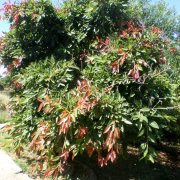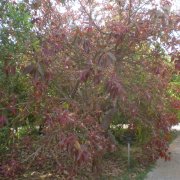Care of the tree Ficus ingens or Red-leaved fig |
|
The genus Ficus, family Moraceae, includes 900 species of trees, shrubs, and climbing plants. Some species are: Ficus ingens, Ficus deltoidea, Ficus carica, Ficus binnendijkii, Ficus elastica, Ficus salicaria, Ficus benjamina, Ficus lyrata, Ficus radicans, Ficus pumila, Ficus retusa, Ficus cyathistipula, Ficus rubiginosa. Common names: Red-leaved fig, Red-leaved rock fig. This species is native to South Africa. They are semi-evergreen trees with an extended or rounded crown that reach 15 meters (49.2 feet) in height. The leathery, shiny leaves are lanceolate or heart-shaped, 16 cm in length, and coppery or reddish in color when they sprout (later turn green). They produce small edible fruits that attract birds. Red-leaved fig is used in rockery, as shade trees, as bonsai and in large pots for patios and terraces. It is important not to grow it near buildings because the roots are so aggressive that they can break rocks. It's ideal for Mediterranean coastal gardens. Ficus ingens prefers full sun exposure and warm weather. It's preferable not to expose it to less than 5 ºC (41 ºF). The soil must drain very well and contain organic matter. It can be grown on rocky and poor substrates. Water regularly in spring and summer waiting until the substrate has almost dried. In autumn reduce watering; water sporadically in winter. Fertilize with compost in late winter. Red-leaved rock fig no needs for pruning. Ficus ingens is a resistant plant to the usual pests and diseases. Red-leaved fig propagates easily by cuttings in spring or summer. |
Images of the tree Ficus ingens or Red-leaved fig |
Find plants
Ficus ingens or Red-leaved fig | Care and Growing
© 2025 FavThemes



